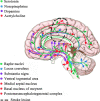Post-stroke depression: mechanisms, translation and therapy
- PMID: 22348642
- PMCID: PMC3822966
- DOI: 10.1111/j.1582-4934.2012.01555.x
Post-stroke depression: mechanisms, translation and therapy
Abstract
The interaction between depression and stroke is highly complex. Post-stroke depression (PSD) is among the most frequent neuropsychiatric consequences of stroke. Depression also negatively impacts stroke outcome with increased morbidity, mortality and poorer functional recovery. Antidepressants such as the commonly prescribed selective serotonin reuptake inhibitors improve stroke outcome, an effect that may extend far beyond depression, e.g., to motor recovery. The main biological theory of PSD is the amine hypothesis. Conceivably, ischaemic lesions interrupt the projections ascending from midbrain and brainstem, leading to a decreased bioavailability of the biogenic amines--serotonin (5HT), dopamine (DA) and norepinephrine (NE). Acetylcholine would also be involved. So far, preclinical and translational research on PSD is largely lacking. The implementation and characterization of suitable animal models is clearly a major prerequisite for deeper insights into the biological basis of post-stroke mood disturbances. Equally importantly, experimental models may also pave the way for the discovery of novel therapeutic targets. If we cannot prevent stroke, we shall try to limit its long-term consequences. This review therefore presents animal models of PSD and summarizes potential underlying mechanisms including genomic signatures, neurotransmitter and neurotrophin signalling, hippocampal neurogenesis, cellular plasticity in the ischaemic lesion, secondary degenerative changes, activation of the hypothalamo-pituitary-adrenal (HPA) axis and neuroinflammation. As stroke is a disease of the elderly, great clinical benefit may especially accrue from deciphering and targeting basic mechanisms underlying PSD in aged animals.
© 2012 The Authors Journal of Cellular and Molecular Medicine © 2012 Foundation for Cellular and Molecular Medicine/Blackwell Publishing Ltd.
Figures


References
-
- Hachinsky V. Post-stroke depression, not to be underestimated. Lancet. 1999;353:1728. - PubMed
-
- Robinson RG, Bolduc PL, Price TR. Two-year longitudinal study of poststroke mood disorders: diagnosis and outcome at one and two years. Stroke. 1987;18:837–43. - PubMed
-
- Whyte EM, Mulsant BH, Vanderbilt J, et al. Depression after stroke: a prospective epidemiological study. J Am Geriatr Soc. 2004;52:774–8. - PubMed
-
- Morris PL, Robinson RG, Andrzejewski P, et al. Association of depression with 10-year post-stroke mortality. Am J Psychiatry. 1993;150:124–9. - PubMed
Publication types
MeSH terms
Substances
LinkOut - more resources
Full Text Sources
Medical
Research Materials

